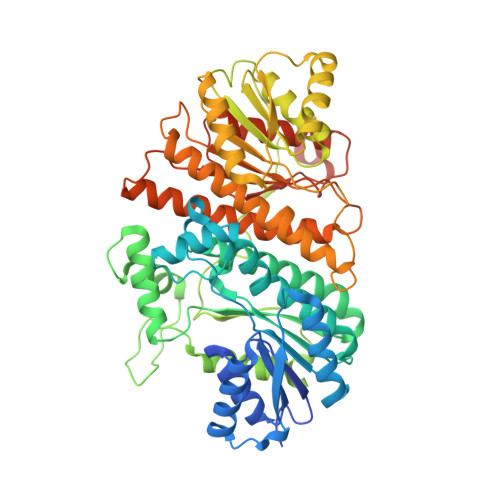Structural insight into bi-functional malonyl-CoA reductase.
Son, H.F., Kim, S., Seo, H., Hong, J., Lee, D., Jin, K.S., Park, S., Kim, K.J.(2020) Environ Microbiol 22: 752-765
- PubMed: 31814251
- DOI: https://doi.org/10.1111/1462-2920.14885
- Primary Citation of Related Structures:
6K8S, 6K8T, 6K8U, 6K8V, 6K8W - PubMed Abstract:
The bi-functional malonyl-CoA reductase is a key enzyme of the 3-hydroxypropionate bi-cycle for bacterial CO 2 fixation, catalysing the reduction of malonyl-CoA to malonate semialdehyde and further reduction to 3-hydroxypropionate. Here, we report the crystal structure and the full-length architecture of malonyl-CoA reductase from Porphyrobacter dokdonensis. The malonyl-CoA reductase monomer of 1230 amino acids consists of four tandemly arranged short-chain dehydrogenases/reductases, with two catalytic and two non-catalytic short-chain dehydrogenases/reductases, and forms a homodimer through paring contact of two malonyl-CoA reductase monomers. The complex structures with its cofactors and substrates revealed that the malonyl-CoA substrate site is formed by the cooperation of two short-chain dehydrogenases/reductases and one novel extra domain, while only one catalytic short-chain dehydrogenase/reductase contributes to the formation of the malonic semialdehyde-binding site. The phylogenetic and structural analyses also suggest that the bacterial bi-functional malonyl-CoA has a structural origin that is completely different from the archaeal mono-functional malonyl-CoA and malonic semialdehyde reductase, and thereby constitute an efficient enzyme.
Organizational Affiliation:
School of Life Sciences (KNU Creative BioResearch Group), KNU Institute for Microorganisms, Kyungpook National University, Daegu, South Korea.
















